You are reading the second part of the article MaaS and freedom (here the first part).
Can MaaS, by winking at sustainability, give us freedom of movement?
In the first part of this article we started to think about this question, starting from the difference between “transport” and “mobility“, passing through the concept of digitization of supply and demand up to talk about the “magic” that originates from the union of supply and demand on a purely digital level.
From these concepts begins this second and final part of “MaaS and freedom”; we will try to understand together whether MaaS can actually give us, without neglecting environmental sustainability, the freedom of movement that we all desire.
The three arrows diagram
In the first part of the article we have progressively constructed the three arrows diagram, which is shown below.
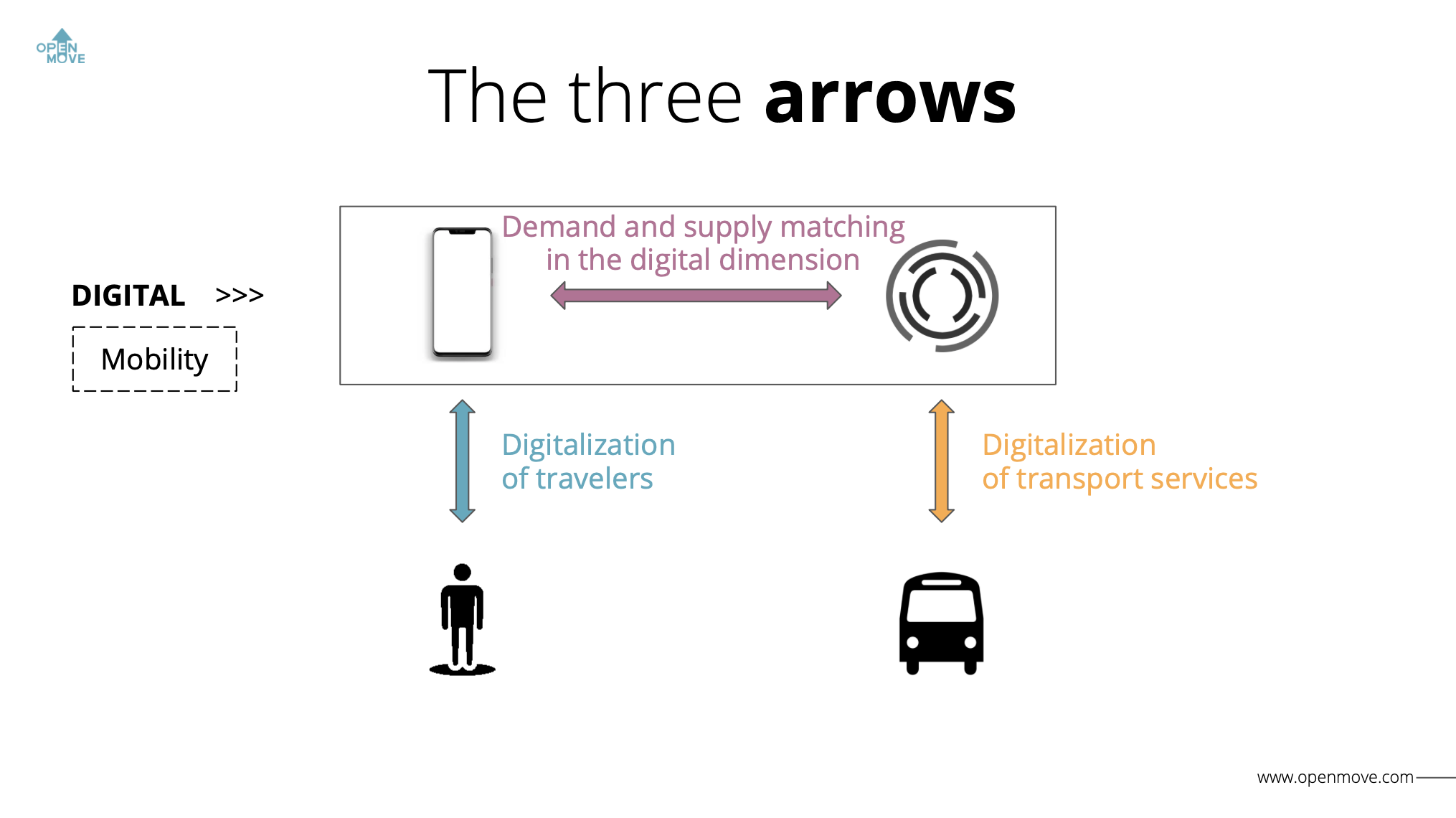
With regard to the three arrows diagram, it is important to remember that:
- the scheme arises from the matching of supply and demand: the demand for mobility is located on the left side and is represented by the user who wants to move; the mobility offer is instead on the right side of the diagram and is identified with the icon of a bus, although similarly we could replace it with the icon of any other transport service;
- the scheme is divided into two fundamental parts: the first is made up of the two vertical arrows which represent the digitization processes (of the demand for mobility on the left, of the offer on the right), the second is formed by the horizontal arrow at the top, which is the heart of this article and the theater of innovation in the world of mobility for many years.
The first part of this article ended with the analysis of some important innovations, specifically the cases of Flixbus, Uber and the phenomenon of micro mobility. Before proceeding with this second article, it is recommended to read the first part.
MaaS and the three arrows
At this point a more than legitimate question arises: does the three arrows diagram allow us to talk about MaaS?
The answer is yes; the three arrows diagram allows it, but on one condition (necessary but not sufficient): that the transport services present consist of more than a single mode. This is because a product serving the end user must intrinsically contain many – ideally all – of the available mode of transport on any given territory. MaaS means having a holistic view of mobility.
In the event that the three arrows diagram remains unimodal, the horizontal arrow at the top cannot be called MaaS, but will have other names: “app of a public transport agency”, “e-commerce of a single operator”, “FlixBus app” just to give some examples. There is nothing wrong with these products, on the contrary, they respond to specific needs of digital users and, if implemented artfully, they can give rise to projects with particularly interesting results. But MaaS is another thing: without multimodality one cannot speak of MaaS.
What is seen in the first part of this article, that is the construction of the three arrows diagram, refers to a single mode of transport (whatever it is). In this second part we talk about MaaS, or the integration of multiple transport services that are put into the system for the end user. Let’s make an analogy to better understand this difference. In the first part of the article the parallel is with an e-commerce of a single manufacturer (suppose, for example, of shoes), in the second part, that of MaaS, the analogy is with a marketplace – think about Amazon – in which the products of several suppliers are harmonized, as well as items and services belonging to different categories (shoes of each brand and model, but also sweaters, hats, books, watches, appliances, etc.). MaaS means all types of bus services (urban, suburban, etc.) but also metro, train, parking, bike sharing, micro mobility and so on and so forth.
Visual definition of MaaS
What is the definition of MaaS?
To define MaaS we now report one of the most authoritative and clear definitions, that of the MaaS Alliance. MaaS is “the integration of multiple transport services into a single mobility service accessible on demand”. This definition is compact and precise and the three arrows diagram allows you to have a visual representation of it. Let’s see in detail why.
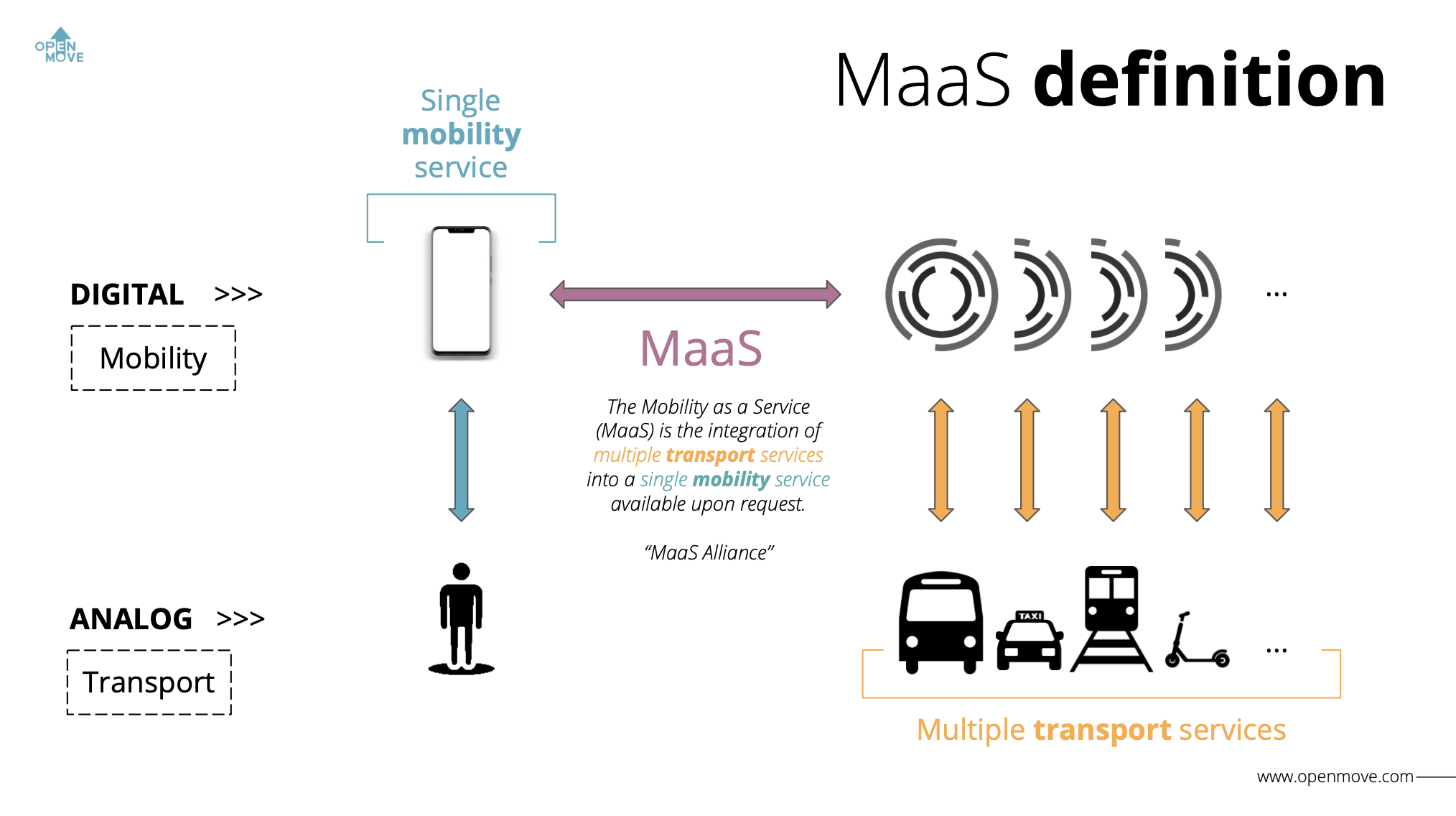
Let’s break this definition down into three parts:
- “The integration of multiple transport services …” → this first part of the definition is visible in the lower right part of the three arrows diagram. As seen before, it is not possible to speak of MaaS with a single transport service. No multimodality, no MaaS.
- “… in a single mobility service …” → the single mobility service is represented by the smartphone on the top left, the digital counterpart of the end user. If before we talked about multiplicity, here we talk about one single service. The user must be able to take advantage of a global mobility offer from a single app.
- “… accessible on request” → we begin to discover one of the first forms of freedom for the user that MaaS underlies: it is the freedom to be able to access, on one’s own initiative, when and where it is needed, to a single mobility service to reach multiple transport services. Without digital this would not be possible.
Another important concept emerges from the definition: in part 1 we talk about transport, meaning an analogical, physical and tangible dimension. In part 2, vice versa, the term mobility is used, referring to a digital dimension. The distinction between transport and mobility is better addressed in the first part of the article.
The three arrows diagram allows us to come up with another definition of MaaS in addition to that of the MaaS Alliance: by thinking of the horizontal arrow at the top, MaaS can be defined as the digital meeting point of supply and demand for mobility in an intermodal perspective.
Other definitions of MaaS
There are numerous other definitions of MaaS which, for completeness of the discussion, we summarize and report below. Each of these definitions brings with it the wealth of different points of view of the same basic concept. None of these definitions conflict with what has been previously described in this article.
MaaS can also be defined as:
- mobility at your service, upon request
- multiple transport services in a single app
- holistic view of mobility
- transformation of the way we choose how to go from A to B
- customer-centric transport model
- optimization of the existing mobility network
- opportunities to improve the movement of people and goods
- prerequisite for rethinking the transport offer
- over-the-top mobility service
- collaboration between transport modes
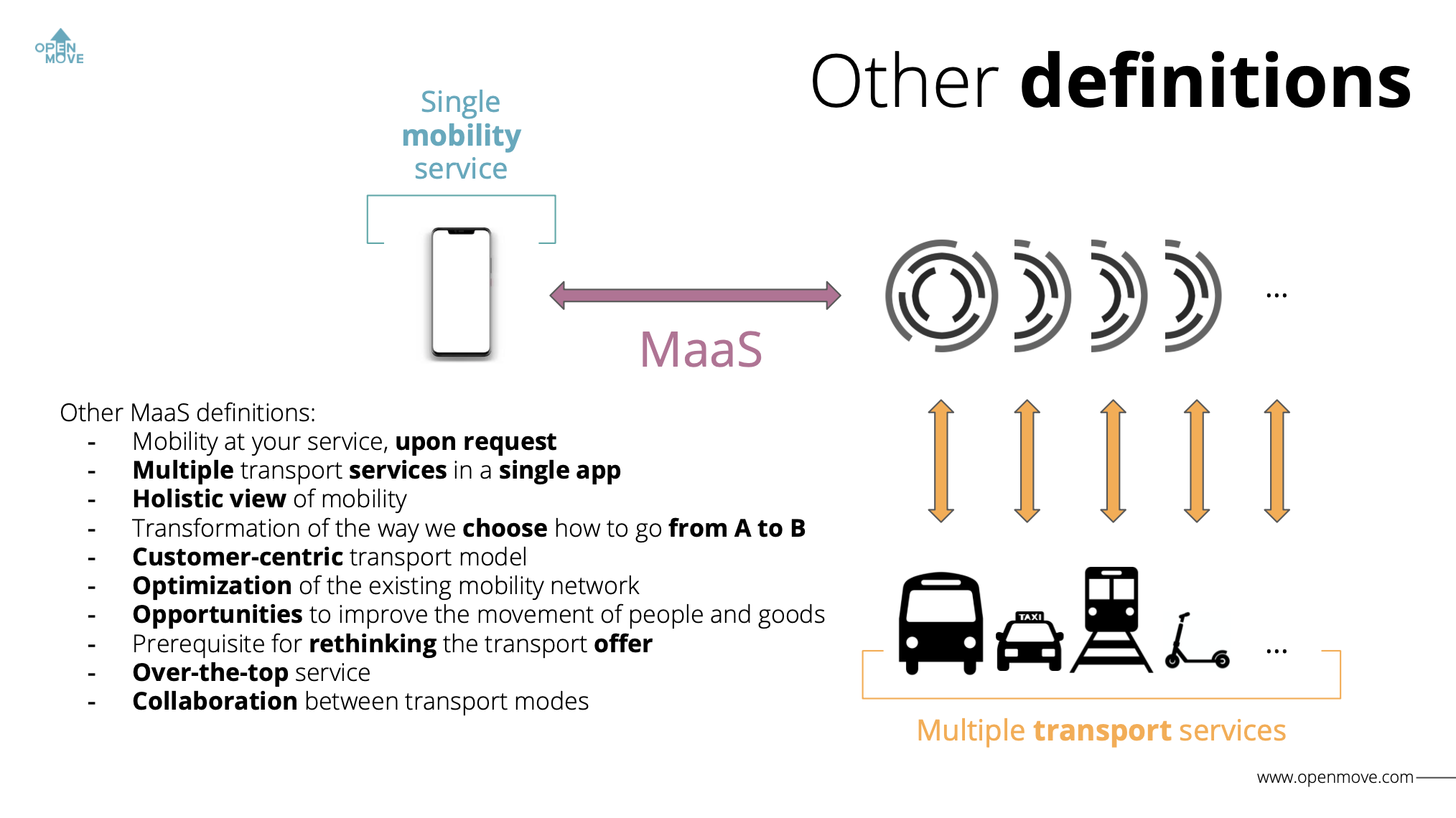
From these definitions a second declination of “freedom” emerges which is added to the first, relating to access on demand (on-demand mobility). This second declination of freedom is the possibility of going from point A to point B. MaaS must allow you to move where you want without restrictions and this, for the end user, is freedom of movement.
MaaS Integrator and MaaS Operator
The horizontal arrow representing MaaS has a problem: it contains a multiplicity of different professional and technical skills.
Studies and projects on the topic in recent years have highlighted the need and / or opportunity to break the horizontal arrow into two parts. In other words, they realized that, in the new value chain that has been created with MaaS, there are missing links given the current stakeholders. These missing activities can be clustered into two macro categories that outline two new roles: that of the MaaS Operator and that of the MaaS Integrator.
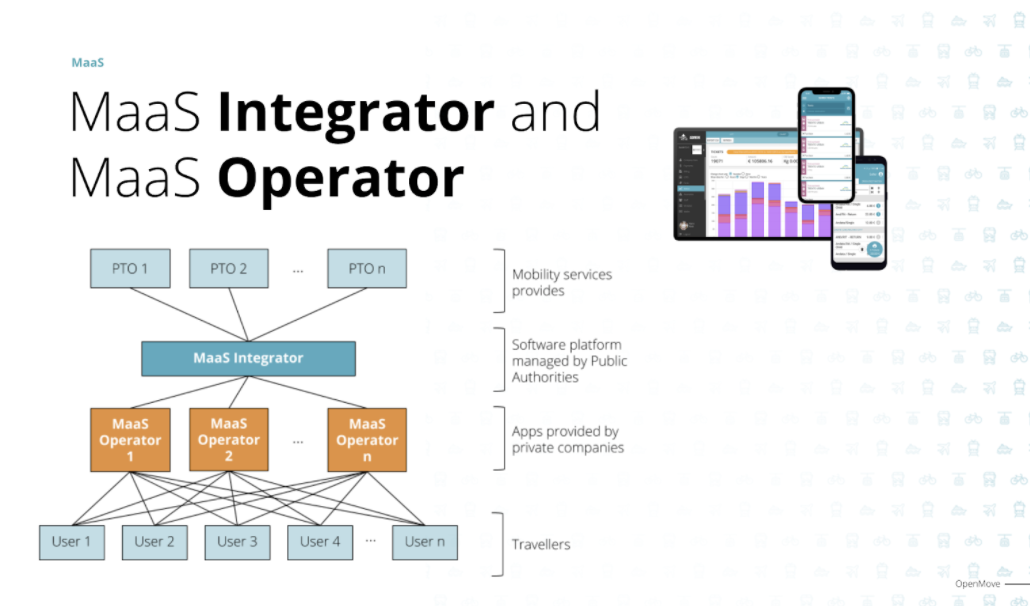
Let’s try to define these two new actors:
- the MaaS Operator → is a digital mobility operator that, through a single platform, conveys multiple transport solutions to end users in a multimodal way;
- the MaaS Integrator → plays a role of transport software integrator, with the mission of putting to system various transport services for one or more MaaS Operators.
MaaS Integrator and MaaS Operator are located between the demand for mobility (represented by end users) and the offer of mobility, made up of the various transport operators – public and private – with the related assets and services. This relationship is clearly visible in the image above. The following diagram instead allows you to highlight the difference between the Maas Operator and the MaaS Integrator within the three arrow diagram.
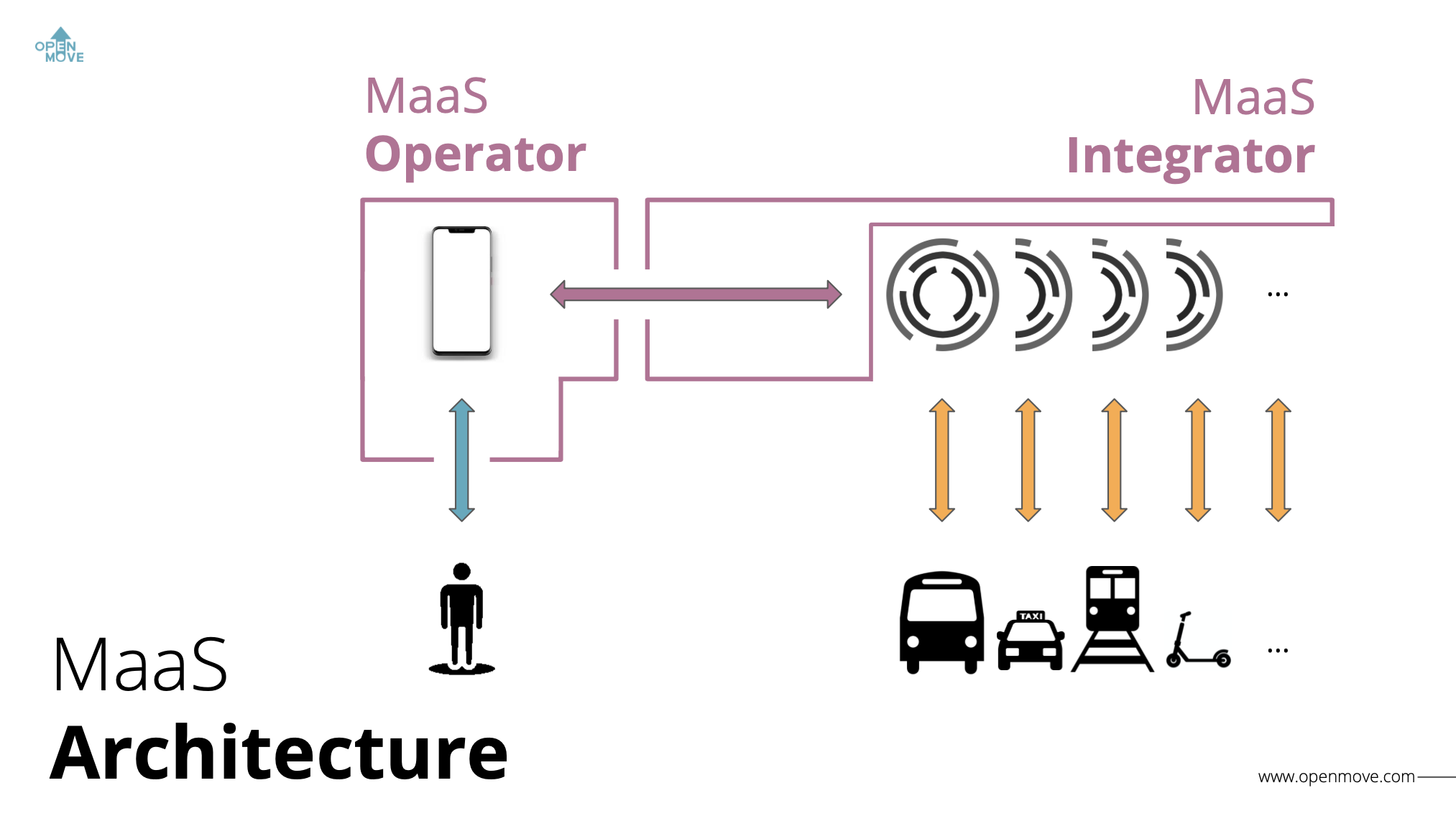
The image above allows you to understand that the MaaS Operator has direct contact with the end user. The business of the MaaS Operator is B2C type and therefore requires having (or seeking in a technical supplier) IT skills in the design and development of mobile apps dedicated to end users. More and more it can be said that our preferred transport mode is our smartphone. Qualitative digital products are needed, matching the expectations due to the technological confidence of digital users.
The box that segments the skills of the MaaS Operator on the three arrows diagram comprehends the user digitization process, including the end user app which is important, but alone does not constitute MaaS. MaaS is not just an app!
The MaaS Integrator, unlike the MaaS Operator, works in a purely B2B or B2G market, with the aim of systematising the existing digitalisations for each single mode of transport. In this case, a deep knowledge in the transport domain is needed, because the main activity is to integrate what is available from the various ITS systems (Intelligent Transport System).
The scope of action of the MaaS Integrator does not include ITS systems, although, in many cases it is necessary to make up for any lack of digitization of the offer. We refer in particular to the orange vertical arrows and the circles above which make up the ITS systems: if they are not present or do not reach an adequate quality level then you must fill this gap before you can think about MaaS. If there is no AVL / AVM system, it is not possible to have the position of the vehicles in real time and this limits the potential of the MaaS. A MaaS project can be stopped as abruptly as a user who is physically stuck in front of a turnstile that cannot be opened by an app, a bike that cannot be booked by smartphone, a train ticket that cannot be purchased with a few simple clicks. These are small daily problems in tackling MaaS projects. Digitization is an indispensable prerequisite, but at the same time making MaaS does not mean making ITS systems!
MaaS and freedom
It is time to draw conclusions and try to answer the question we asked ourselves in the first place: can MaaS, winking at sustainability, respond to our desire for freedom of movement?
We summarize the basic steps of the first and second part of the article:
- digitization of the demand for mobility
- digitization of the mobility offer
- union of supply and demand in the three arrows diagram
- importance of supply and demand matching on a digital level
- horizontal arrow as a theater for mobility innovation
- MaaS and the three arrows diagram in multimodal version
- definitions of MaaS
- new roles in the value chain: MaaS Operator and MaaS Integrator
The goal of this article is to help shed some light on the MaaS topic. It can be said without fear that it is not a simple matter: the objectives of a MaaS project are as strategic as they are ambitious. The three arrows diagram and the MaaS architecture allow us to reflect on how complex a project of this type can be. The following questions – deliberately – put even more irons in the fire:
- What does sufficient digitalisation of the transport offer mean? Which ITS systems are ready for MaaS and which are not? What to do if transportation data is not made available? How to be open to the new forms of transport of the future?
- Who is called upon to play the key roles of MaaS Operator and MaaS Integrator? What is the role of the Public Administration, what is the role of private entities? Who can have the reins of the mobility of a territory and with what purpose?
- Who is responsible for creating rate bundles? Who owns the relationship with users? Who is responsible if the user has problems during a move? Is there a risk of being platformized by an over-the-top service?
- How to deal with the fear of competition between mobility services? How to position MaaS to be the catalyst for mobility through intermodal collaboration? Is it possible to encourage more sustainable transport services?
The intrinsic complexity of mobility, if not addressed from a MaaS perspective, relentlessly falls on the end user. This complexity discourages people and compels them to make less than optimal choices for global sustainability. The choice of driving a private car – the least sustainable mode of transport – is often a choice dictated by the complexity of the alternatives, in particular as regards the problem of the first and last mile.
How many times have we happened to not understand how to find the necessary information to travel by bus? Or how and where to buy a ticket? An even worse question that, by definition, has no answer: how many better journeys (faster, cheaper, less polluting) could we have done but we didn’t do because we were not aware or just out of habit? MaaS bases its value on the information it manages to give and the access to mobility that it can guarantee: information makes us free, access even more.
The correct governance of a MaaS platform is an opportunity to exercise control and optimization of mobility, which are possible only with a holistic vision of mobility.

MaaS increases our ability to move simply because it relieves us of the complexity of transport itself, allowing us to choose between various options for moving from point A to point B: it is the task of the MaaS Integrator to combine disparate transport offers together and of the MaaS Operator to offer them in a clear and persuasive way, with the same simplicity that pushes you to get on your car and leave. MaaS absorbs the complexity of transport to leave all of us the freedom of movement.


